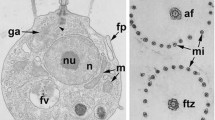Abstract
Mesostigma viride Lauterborn (Prasinophyceae) is the first green flagellate found to have multilayered structures (MLS) in its flagellar apparatus. MLS's were previously known from green algae only in charophycean swarmers, linking theCharophyceae to the origin of land plants, whose male gametes (when flagellated) also possess an MLS.M. viride is, therefore, probably more closely related to the origin of theCharophyceae than any other green flagellate that has been thoroughly studied so far. The occurrence of MLS's in green flagellates and apparently in other algae and protozoans suggests that an MLS occurred in an ancient group of flagellates and has survived in various protistan lines, including the line of green algae related to land plants. The occurrence of a synistosome inM. viride and other of its characteristics suggest that it is more closely related toPyramimonas than to other genera of scaly green flagellates.
Similar content being viewed by others
References
Brugerolle, G., Joyon, L., 1973: Sur la structure et la position systématique du genreMonocercomonoides (Travis 1932). — Protistologica9 (1), 71–80.
, 1975: Étude cytologique ultrastructurale des genresProteromonas etKarotomorpha (Zoomastigophorea Proteromonadida Grasse 1952). — Protistologica11 (4), 531–546.
Carothers, Z. B., Kreitner, G. L., 1967: Studies of spermatogenesis in the Hepaticae. I. Ultrastructure of the vierergruppe inMarchantia. — J. Cell Biol.33, 43–51.
Domozych, D. S., 1980: The comparative aspects of cell wall chemistry in the green algae (Chlorophyta). — J. Mol. Evol.15, 1–12.
- A developmental analysis of the unicellular green algaPteromonas protracta (Volvocales, Chlorophyta): Cell wall development and the role of the endomembrane system. — Can. J. Bot. (in review).
, 1981: The role of microtubules during the cytokinetic events of cell wall ontogenesis and papilla formation inCarteria crucifera. — Protoplasma103, 193–204.
-Stewart, K. D., Mattox, K. R.: Development of the cell wall inTetraselmis: Role of the Golgi apparatus and extracellular wall assembly. — J. Cell. Sci. (in press).
Manton, I., Ettl, H., 1965: Observations on the fine structure ofMesostigma viride Lauterborn. — J. Linn. Soc. (Bot.)59, 378, 175–184.
Marchant, H. J., Pickett-Heaps, J. D., Jacobs, K., 1973: An ultrastructural study of zoosporogenesis and the mature zoospore ofKlebsormidium flaccidum. — Cytobios8, 95–107.
Mattox, K. R., Stewart, K. D., 1977: Cell division in the scaly green flagellateHeteromastix angulata and its bearing on the origin of theChlorophyceae. — Am. J. Bot.64, 931–945.
Melkonian, M., 1980: Ultrastructural aspects of basal body associated fibrous structures in green algae: A critical review. — BioSystems12, 85–104.
Mignot, J. P., 1967a: Structure et ultrastructure de quelques chloromonadines. — Protistologica3, 5–23.
Moestrup, Ø, 1978: On the phylogenetic validity of the flagellar apparatus in green algae and other chlorophyll a and b containing plants. — BioSystems10, 117–144.
, 1979: A light and electron microscopical study ofNephroselmis olivacea (Prasinophyceae). — Opera Bot.49, 4–39.
Norris, R. E., Pearson, B. R., 1975: Fine structure ofPyramimonas parkae sp. nov. (Chlorophyta, Prasinophyceae). — Arch. Protistenk.117, 192–213.
Pearson, B. R., Norris, R. E., 1975: Fine structure of cell division inPyramimonas parkae Norris etPearson (Chlorophyta, Prasinophyceae). — J. Phycol.11, 113–124.
Rogers, C. E., Mattox, K. R., Stewart, K. D., 1980: The zoospore ofChlorokybus atmophyticus, a charophyte with sarcinoid growth habit. — Am. J. Bot.67 (5), 774–783.
-Stewart, K. D., Mattox, K. R., 1980: The taxonomic distribution of multilayered structures. — J. Phycol.16, Suppl. 135.
Sluiman, H. J., Roberts, K. R., Mattox, K. R., Stewart, K. D., 1981: Comparative cytology and taxonomy of theUlvaphyceae. I. The zoospore ofUlothrix zonata (Chlorophyta). — J. Phycol.16, 537–545.
Stewart, K. D., Mattox, K. R., 1975: Comparative cytology, evolution and classification of the green algae with some consideration of the origin of other organisms with chlorophylls a and b. — Bot. Rev.41, 104–135.
, 1978: Structural evolution in the flagellated cells of green algae and land plants. — BioSystems10, 145–152.
, 1980: Phylogeny of phytoflagellates. — InCox, E. R., (Ed.):Phytoflagellates. (Developments in Marine Biology, Vol.2.) — New York: Elsevier/North-Holland.
Author information
Authors and Affiliations
Additional information
This work was supported by National Science Foundation Grant DEB-78-03554.
Rights and permissions
About this article
Cite this article
Rogers, C.E., Domozych, D.S., Stewart, K.D. et al. The flagellar apparatus ofMesostigma viride (Prasinophyceae): Multilayered structures in a scaly green flagellate. Pl Syst Evol 138, 247–258 (1981). https://doi.org/10.1007/BF00985188
Received:
Issue Date:
DOI: https://doi.org/10.1007/BF00985188



